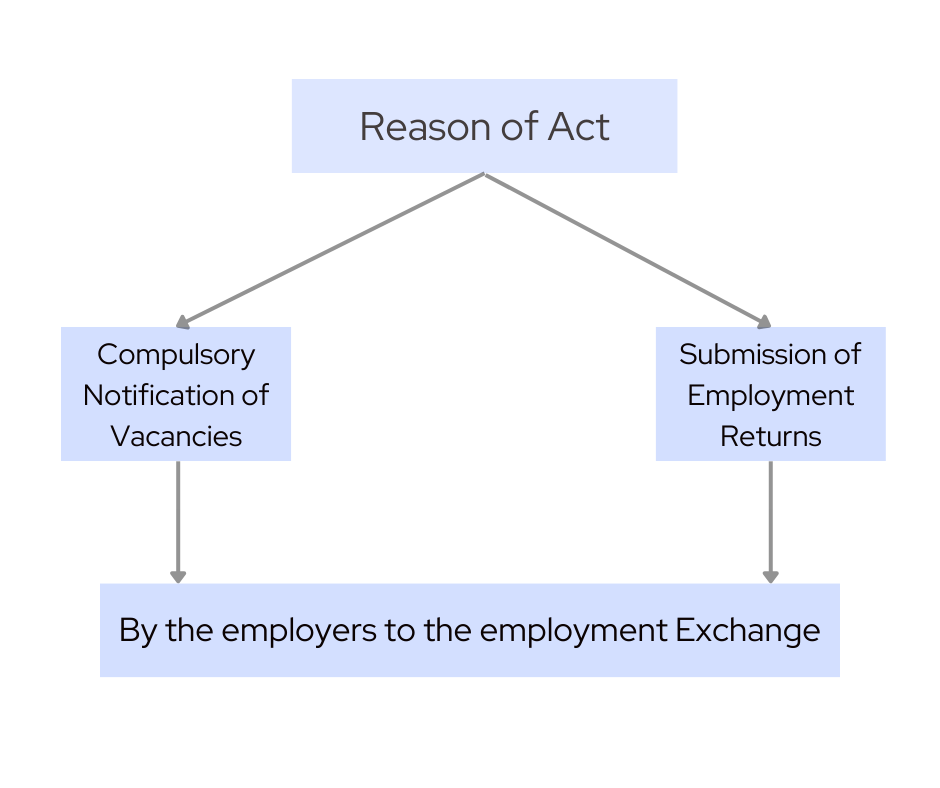Introduction to the Employment Exchanges Act
The Employment Exchanges Act of 1959 is a significant legislation in India that aims to regulate the operations of employment exchanges and facilitate the exchange of employment-related information between job seekers and employers.

Key provisions of the Employment Exchanges Act:
Historical Background of Employment Exchanges Act
The Employment Exchanges Act of 1959 was introduced in response to various historical and socio-economic factors in India during that period.
Here is the historical backdrop:

Inspections and Compliance under Employment Exchanges Act
The Employment Exchanges Act and rules of 1959 primarily focuses on the establishment and functioning of employment exchanges rather than traditional inspections and enforcement of labour laws compliance. However, there are measures in place to ensure that employment exchanges adhere to the Act and effectively fulfil their roles. Here is an overview:
Employment exchanges have grievance redressal mechanisms in place to address complaints from job seekers or employers regarding the services provided. These mechanisms promote accountability and transparency in the exchanges’ functioning.
Governments invest in training and capacity building programs for employment exchange staff to enhance their skills and knowledge. This ensures that staff can provide quality services to job seekers and employers while staying updated on relevant Indian labour law and procedures.
Governments may implement quality assurance measures to ensure that employment exchanges provide effective services to job seekers and employers. This can include setting performance targets, conducting satisfaction surveys, and evaluating the impact of placement services.
The government oversees the functioning of employment exchanges, as it establishes and administers them. Government departments responsible for labour and employment monitor the exchanges’ performance to ensure they meet Indian labour laws act objectives.
Instead of formal inspections, employment exchanges may undergo internal audits or reviews to assess their performance, adherence to procedures, and compliance with Employment Exchange Act 1959. These audits help identify areas for improvement and ensure efficient functioning.
Employment agencies might need to provide routine updates to the government or appropriate agencies, outlining their operations, accomplishments, and obstacles. These summaries allow the government to evaluate the effectiveness of the agencies and implement any needed adjustments.
Recent Developments and Amendments in the Employment Exchanges (Compulsory Notification of Vacancies) Act, 1959 in India:
Impact on Employment of employment exchange Act:

The Employment Exchanges (Compulsory Notification of Vacancies) Act, 1959, was enacted with the aim of streamlining the job matching process and establishing a structured mechanism for employers to notify job vacancies. Since its implementation, this Act has had both positive and challenging impacts on employment in India.
Challenges and Limitations of employment exchange Act:
Recent Improvements and Future Prospects:
- The National Career Service (NCS) portal and mobile apps have revolutionized employment exchanges, making them more accessible and efficient.
- Digital Literacy Programs: Initiatives aimed at enhancing digital literacy among job seekers can greatly improve their ability to effectively utilize online job search platforms.
- Encouraging employers through incentives and recognition for notifying vacancies can significantly enhance compliance and participation as per labour laws in India.
- Collaborations with private job portals and recruitment agencies can greatly expand the reach and impact of employment exchanges through public-private partnerships.
- Employment exchanges are increasingly being linked with skill development programs to ensure that job seekers possess the necessary skills to meet market demands.
- Data from employment exchanges is being utilized to design customized training programs that address specific skill shortages.
- Continuous updates and amendments to the Act ensure its relevance and effectiveness in a dynamic job market as per labour laws in India.
- Investments in infrastructure and capacity building for employment exchanges can greatly improve their efficiency and effectiveness.
Employment exchange registration process online:
Registering with an employment exchange entails signing up with a government-operated agency to explore job openings. This facility is commonly offered by the state or federal government and is designed to facilitate the connection between individuals looking for employment and potential employers.
Important Websites:
For further information and specific guidelines, please visit the official websites of the following employment exchanges:
- National Career Service (NCS)
- Tamil Nadu Employment Exchange
- Kerala Employment Exchange
- Karnataka Employment Exchange
- Delhi Employment Exchange
Please ensure the official website of your state’s employment exchange for detailed guidelines and requirements.
Steps for Employment Exchange Registration:
- Visit the Employment Exchange (if necessary): In certain cases, you may need to visit the employment exchange office in person for document verification. Be sure to check the specific requirements of your state.
- Access the Official Website: Each state has its own employment exchange portal. Access the official employment exchange website of your state.
- Account Registration: Account registration is required for new users. Find the ‘New User Registration’ or a comparable feature.
- Enter necessary details: like your name, date of birth, educational qualifications, address, etc.
- Sign in to Your Account: After registration, sign in to your account using the login credentials provided during registration.
- Complete the Application Form: Fill out the application form with correct personal, educational, and professional information.
- Upload essential documents: like educational certificates, proof of residence, and identity proof.
- Submit the Form: Review the information in the application form and submit it online.
- Obtain Registration Number: Upon successful submission, you will receive a registration number. This number is important for future reference and job applications through the employment exchange.
Required Documents:
- Educational Certificates: Please provide proof of your educational qualifications, including marksheets and certificates.
- Proof of Residence: You will need to submit documents such as Aadhar card, voter ID, ration card, or any other valid proof of residence.
- Identity Proof: Please provide a copy of your Aadhar card, PAN card, driving license, or any other valid identity proof.
- Caste Certificate: If applicable, please provide a caste certificate as required.
- Passport-sized Photographs: You will need to submit recent photographs in the specified format.
Benefits of Registration:
You can get an employment exchange certificate after the registration for employment exchange.
- Access to Job Listings: By registering with the employment exchange, you will gain access to a wide range of job opportunities listed with us.
- Employment Notifications: Stay updated with notifications about job openings and employment news.
- Career Counselling: Avail career counselling and guidance services provided by our employment exchange to help you make informed decisions about your career.
- Priority in Government Jobs: In certain cases, registered candidates may receive priority for specific government job vacancies.
Employment exchange Re-registration with employment exchanges is a crucial step for job seekers to keep their information current and enhance their chances of finding suitable employment. By following the outlined online process and ensuring timely and accurate updates, job seekers can continue to benefit from the services provided by employment exchanges and improve their prospects in the job market.
State-Wise Employment Exchanges in India:
| State/UT | N.O. Employment Exchanges | Notes |
|---|---|---|
| Andhra Pradesh | 26 | Includes district and university employment exchanges. |
| Arunachal Pradesh | 11 | Covers all districts; special focus on tribal areas. |
| Employment exchange Assam | 52 | Extensive network covering urban and rural areas. |
| Bihar | 47 | Includes employment exchanges in major cities and rural areas. |
| Chhattisgarh (CG) Employment exchange | 27 | Focus on tribal employment. |
| Goa | 2 | Smaller state with fewer exchanges but high registration rates. |
| Gujarat | 41 | Includes specialized exchanges for differently-abled persons. |
| Employment exchange Haryana | 56 | Strong network across both urban and rural areas. |
| Himachal Pradesh (HP) | 12 | Mainly district-level exchanges. |
| Jammu & Kashmir | 21 | Includes exchanges in remote areas. |
| Employment exchange Jharkhand | 43 | Extensive coverage in mining and industrial areas. |
| Karnataka | 40 | Includes IT-focused employment exchanges. |
| Employment exchange Kerala | 90 | High literacy rates reflected in high registration numbers. |
| Madhya Pradesh | 54 | Large state with diverse employment exchange network. |
| Maharashtra | 47 | Includes Mumbai and other major cities; diverse employment sectors. |
| Manipur | 12 | Covers all districts; focus on youth employment. |
| Meghalaya | 11 | Covers both urban and rural areas. |
| Mizoram | 8 | Focus on tribal and rural employment. |
| Nagaland | 8 | Extensive coverage in tribal areas. |
| Employment exchange Odisha | 30 | Includes exchanges in industrial and coastal areas. |
| Punjab | 47 | Strong network in both urban and rural regions. |
| Rajasthan | 66 | Largest state with extensive coverage. |
| Sikkim | 2 | Smaller state with high registration rates. |
| Tamil Nadu | 48 | Includes exchanges in Chennai and other major cities. |
| Telangana | 22 | Network expanding post-state formation. |
| Tripura | 12 | Includes specialized exchanges for rural areas. |
| Employment exchange (UP)Uttar Pradesh | 90 | Highest number of exchanges due to large population. |
| Uttarakhand | 24 | Covers hilly and remote areas. |
| West Bengal | 73 | Extensive network covering diverse regions. |
| Andaman & Nicobar Islands | 1 | Single exchange covering the entire UT. |
| Chandigarh | 1 | Single exchange catering to the union territory. |
| Dadra & Nagar Haveli | 1 | Single exchange covering the UT. |
| Daman & Diu | 2 | Each district has its own exchange. |
| Employment exchange Delhi | 14 | Includes specialized exchanges for different sectors. |
| Lakshadweep | 1 | Single exchange covering the UT. |
| Puducherry | 4 | Includes exchanges in the main city and outlying regions. |
Employment Exchanges Act:
he Employment Exchanges (Compulsory Notification of Vacancies) Act, 1959 was enacted to ensure that employers notify vacancies to employment exchanges to promote transparency and support employment generation. Over the years, amendments and updates to the Act have been introduced to modernize its applicability and improve its effectiveness.
- The Employment Exchanges (Compulsory Notification of Vacancies) Amendment Act, 1987:
- Expanded the scope of the Act to include establishments in the private sector with 25 or more employees.
- Exempted certain categories of vacancies from notification, such as:
- Vacancies filled by promotion.
- Vacancies for temporary work lasting less than 3 months.
- Vacancies in agriculture (excluding plantations).
- Rules for Online Notification:
- Introduced provisions for online submission of vacancy notifications to employment exchanges.
- Allowed electronic maintenance of employment records, reducing the paperwork burden on employers.
Developments under the National Career Service (NCS):
The Government of India launched the National Career Service (NCS) portal in 2015 to replace the traditional employment exchange system. While the portal complements the Employment Exchanges Act, 1959, it modernizes and digitizes employment services.
Key features of the NCS platform include:
- Integration with employment exchanges across states.
- Direct interaction between job seekers and employers.
- Online registration for job seekers and employers, aligning with the Act’s principles.
Provisions Integrated into the Code on Social Security, 2020:
Some aspects of the Employment Exchanges Act, 1959, were re-examined as part of the labor law consolidation under the Code on Social Security, 2020:
- Strengthened Employer Obligations:
- Employers are still required to notify vacancies in specified sectors.
- Enhanced penalties for non-compliance with vacancy notification requirements.
- Digitization and Simplification:
- Leveraging technology to ensure compliance with notification requirements.
- Reduced bureaucratic delays through centralized digital systems.
Recent Developments and Proposals for Reform:
- Focus on Skill Development:
- Emphasis on aligning vacancy notifications with skill development initiatives to bridge employment gaps.
- Integration with State-level Initiatives:
- States have been encouraged to integrate their employment exchange portals with the National Career Service platform for broader coverage and efficiency.
Summery of The Employment Exchanges Act:
The Employment Exchanges Act 1959 was enacted to address the issue of unemployment and promote economic development in India by establishing a system to match job seekers with employment opportunities.
Overall, the Employment Exchange Act and rules plays a crucial role in facilitating the exchange of employment-related information and connecting job seekers with potential employers in India.
The Employment Exchanges Act FAQs:
What is the role of the government under The Employment Exchanges Act?
Answer: The government plays a key role in establishing and managing employment exchanges at both the central and state levels. It monitors the functioning of these exchanges, ensures data collection on employment trends, and provides support for skill development programs and vocational training.
Can employment exchanges help with government job placements?
Answer: Yes, employment exchanges play a crucial role in facilitating placements for government jobs. Job seekers registered with employment exchanges are often given priority for various government recruitment programs and can be directly informed about job openings in central and state government sectors.
What are the functions of employment exchanges under The Employment Exchanges Act?
Answer: The key functions of employment exchanges include registering job seekers, providing job referrals, maintaining records of job vacancies, offering vocational guidance, and supporting placement services. They also gather statistics on unemployment and labor market trends.
Is registration with employment exchanges mandatory under The Employment Exchanges Act?
Answer: Registration with employment exchanges is voluntary under the Act, but it is strongly encouraged as it enhances a job seeker’s chances of finding employment. It allows individuals to be considered for government and private sector job openings shared by employment exchanges.
How does The Employment Exchanges Act help in providing job opportunities?
Answer: Under the Act, employment exchanges collect data about job seekers and job vacancies from various sectors. They act as a bridge, connecting employers and potential employees by providing job notifications, conducting interviews, and offering job counseling services to candidates.
How are employment exchanges beneficial to job seekers under The Employment Exchanges Act?
Answer: Employment exchanges provide free services to job seekers, helping them find job opportunities suited to their skills and qualifications. They also offer career counseling, vocational training, and information on various employment schemes and government job vacancies.
Who can register with employment exchanges under The Employment Exchanges Act?
Answer: All individuals who are unemployed and seeking employment, regardless of their qualification or skill level, can register with employment exchanges under the Act. This includes skilled and unskilled workers, graduates, and professionals.
What is the purpose of The Employment Exchanges Act?
Answer: The primary purpose of the Act is to regulate and create a centralized employment exchange system in India to help match job seekers with appropriate job openings. It also aims to collect data on unemployment trends and provide vocational guidance to individuals seeking employment.
What is The Employment Exchanges Act, 1959?
Answer: The Employment Exchanges Act, 1959 is an Indian legislation that establishes the Employment Exchange system, aiming to provide job opportunities to unemployed individuals by registering them with government-run employment exchanges. It ensures that job seekers can be matched with suitable employment based on their qualifications and experience.
How can employers use the services of employment exchanges under The Employment Exchanges Act?
Answer: Employers can notify job vacancies to employment exchanges, which will then refer suitable candidates based on the job requirements. Employment exchanges act as intermediaries to help employers find qualified candidates, saving time and resources in recruitment.
Contact Us for Labour Laws Compliances
Need expert assistance with labour laws compliance?
Our top consultants provide comprehensive services to ensure your business adheres to employment regulations. Avoid penalties and protect employee rights with our specialized compliance solutions.

